Domaine Combe Queyzaire, Côtes du Rhône
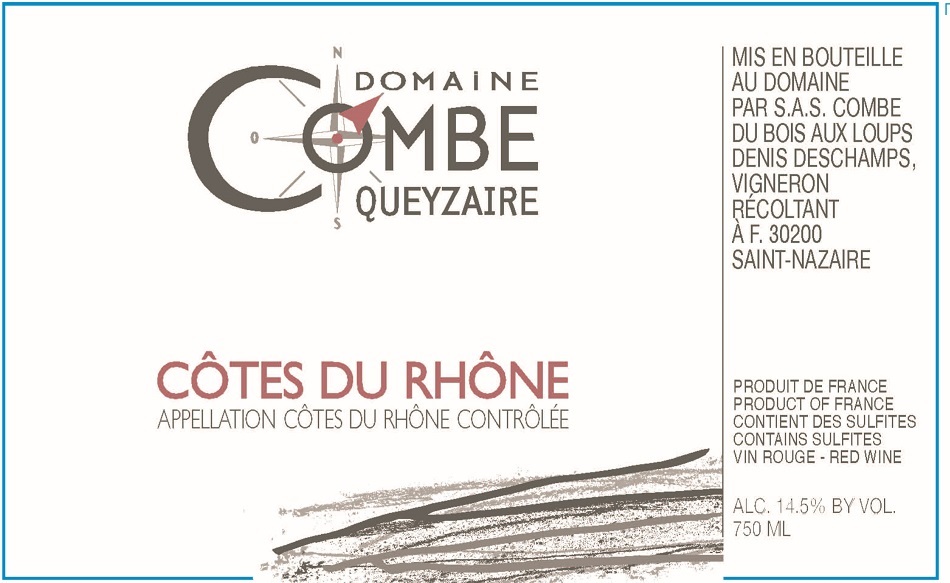
| Country & Region | France, Rhône Valley |
| Appellation(s) | Côtes du Rhône, Côtes du Rhône Villages |
| Producer | Denis Deschamps |
| Founded | 2017 |
D enis Deschamps grew up in the Alpine foothills of Savoie. After earning degrees in enology and viticulture, he took up consulting in 1996 in the completely different terrain of the southern Rhône Valley. Specifically, to the far side of the valley’s mighty river on its right bank, where the prevailing watershed flows eastward off the Massif Central rather than westward off the Alps.
In 2000 he took a gig in production at the Estézargues co-op, further south on the right bank. You know this small co-op’s wine even if you think you don’t: many of its members’ brands are omnipresent in the US market. In the 1990s, the cooperative became a model of non-interventionist winemaking. Its guiding principles included best farming practices; making specific cuvees for each of its ten growers under their labels rather than bulk blends under generic labels; spontaneous ferments without yeast additions; no enzymes; minimal or no fining and filtration; and bottling with a very low dose of sulfur. In 2001 the director of the co-op left for Roussillon to start his own domaine, leaving the direction to his assistant and to Denis Deschamps. In 2002, Denis became the president.
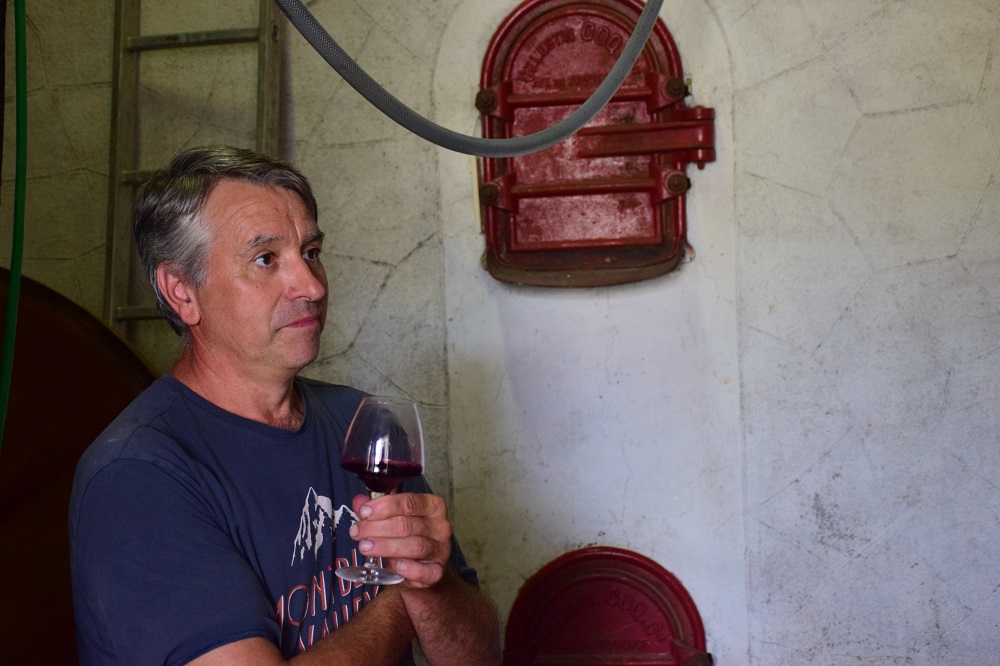
He changed nothing. He tweaked the methods and purchased new equipment, while above all encouraging his growers toward organic farming. Most converted during his tenure, which lasted 18 or 20 years, depending on how you look at it (he handed over the keys but got pulled back in when his successor didn’t pan out). Despite his loyalty, he felt the keen desire to embark on his own venture. He had put in his time and now he wanted to make his own wine from his own vines.
In 2017 he bought three hectares at the end of a small valley (a combe in French) in Saint Nazaire, in the same general area where he had started his consulting career. Since he lives in a neighborhood named Queyrade, he coined Combe Queyzaire for his nascent domaine, combining the place where he comes from with the place where he goes to. In the years that followed, he added parcels in nearby Vénéjan and in Saint-Gervais, all in the Cèze Valley on the right bank of the Rhône. This is the upper end of the Gard department, where the landscape is hillier and cooler, with more forest and rainfall, than much of southern Rhône’s viticulture. For appellation Côtes du Rhône (with or without the superior Villages appendage), you have to go across the plains to the east a good distance before reaching comparable landscape in the Alpine foothills. Historically, such zones often struggled for ripeness, a problem rarely encountered these days but even so the upper Gard harvests later than many southern zones–Denis picked the 2022 vintage between three and four weeks after Estézargues finished harvesting its terrace.
Today, he farms some 37 acres organically divided among over 30 parcels with an average age of at least fifty years. Out of this production, he sells about half in bulk, keeping the finest to make several reds and one white in an old cellar he rents in Saint Nazaire.
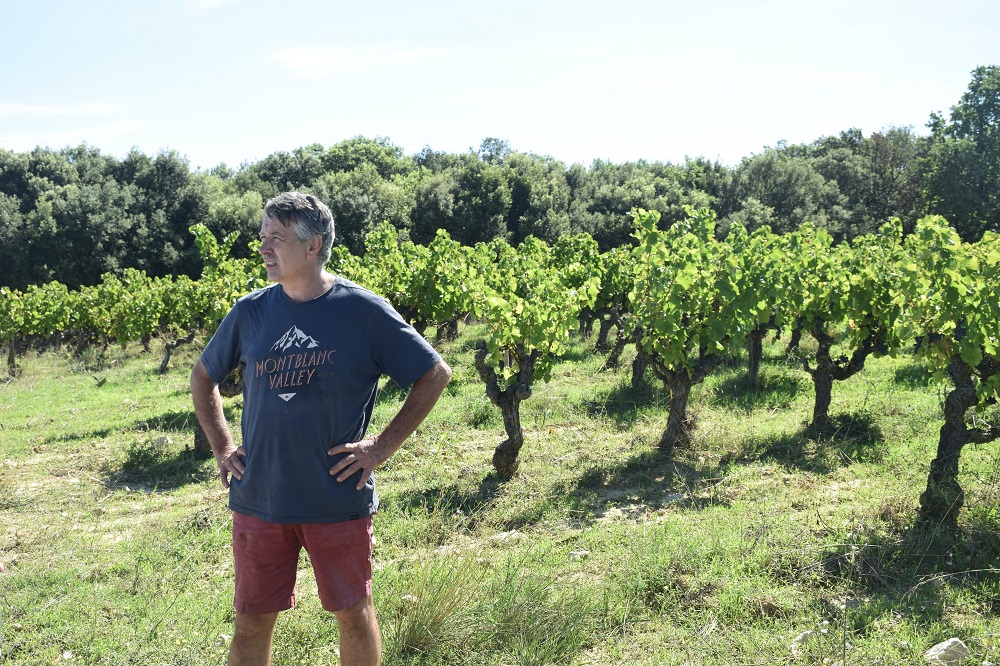
He has three terroirs. The largest, where most of his vines are, is in the western part of Saint Nazaire and in neighboring Saint Gervais, where the foothills of the Massif Central and its forests are most prominent. The wooded environment is key: these vines grow on the edge of the Valbonne national forest, an extended wooded area between the Cève and the Ardèche rivers that brings isolation and coolness. Here the soil is loess, a deep, sandy limestone mix of particulate matter blown over from Siberia back when the earth was cooling and of very poor quality (i.e., perfect for grapes). Below is a cut in a bank of loess next to one of Denis’ parcels.
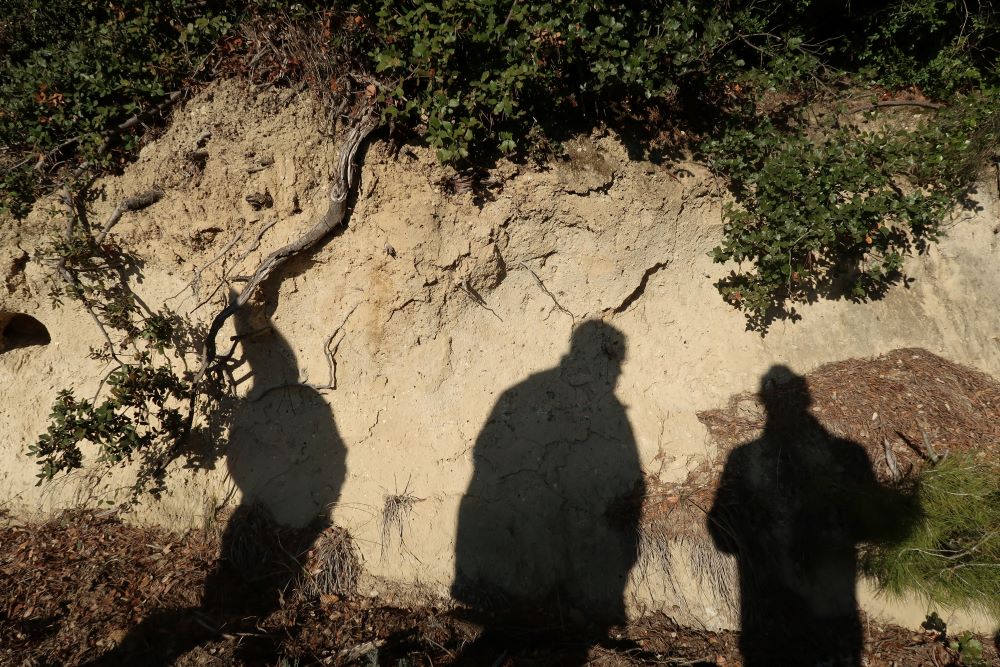
His second terroir is just east of St Nazaire, where there’s no loess but a lot of calcareous stones and thin topsoil on limestone bedrock. His third and smallest terroir, where his Côte du Rhône Villages comes from, is further east on a small terrace or bench made of galets roulés–the round river stones overtop of clay and sand for which Châteauneuf is famous. Such terroirs exist in pockets up and down the right bank of the southern Rhône River.
It would be a real mistake to discount his wine as just another Côtes du Rhône. They’re wines from a master at the top of his game, the best from his old vines that he makes with the same care, skill and principles he used at Estézargues. The difference is that now he’s working on a very artisanal and personal level–aided at harvest by his wife, Noémie.
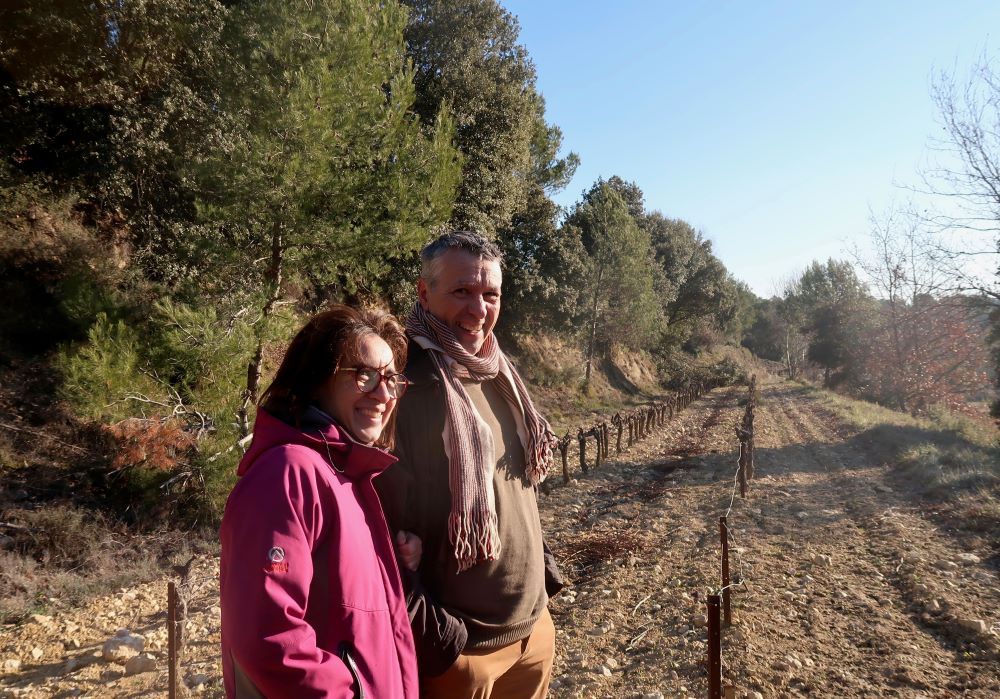
The Wines
| Wine | Blend | Description |
|---|---|---|
| Cuvée Les Aestivalis | Mourvèdre 50%, Carignan 40%, Grenache 10% | This is Denis's homage to the Rhône's vins de soif of yesteryear--they did exist, particularly at bars during the lunch break, and they're coming back--based on his late-ripening varieties and cool sites. One plot per varietal, all old vines thus low yields, with ripening taking long and not coming until the end of the harvest, so low sugars and consequently low alcohols. Harvesting very early in the morning to keep the grapes cold, and beginning the fermentation in concrete to make a red but finishing as if the wine were a rosé, that is, imparting a gentle structure to the wine. Racking into steel for aging and bottling at the end of March following the harvest. This is classified as a Vin de France because it doesn't have enough color to qualify for AOC. The name Aestivalis (es-tee-va-lease) is a play on festivals and été, meaning summer, i.e., a wine for summer to be served with a chill. Denis being the brainy enologist that he is, it's also a reference to a species of North American grapes, Vitis Aestivalis. Tech sheet here. |
| Côtes du Rhône | Grenache, Syrah and Cinsault | This wine comes from sandy loess soils and calcareous soils (limestone for the Rhône is a rare terroir and can give real lift to a wine), and is aged in concrete tanks. The blend is roughly half Grenache and half Syrah with a touch of Cinsault, and yields average around a mere 20 hectoliters per hectare for this and the Villages wine below. Both grapes are de-stemmed but not crushed, which permits a level of carbonic maceration (thus greatly reducing SO2 additions--which is, in fact, the only addition, and a very small one at that). “The spirit remains the same as at Estézargues: to extract the best components of the grapes, adding little else.” Tech sheet here. |
| Côtes du Rhône-Villages | Grenache and Syrah | This is a single-site wine. The vines grow on an ancient river terrace that forms a plateau perched between the Rhône to the east and the limestone massif to the west, and the plateau tilts eastward. The Mistral is very active here. The plateau is 100 meters in altitude, the Syrah grows at either end of the vineyard parcel surrounding the Grenache, and the vines grow amid galets roulés–river stones–overlying garrigue soil, red in color and rich in clay. It’s a terroir similar to Châteauneuf. The vines were planted several times in the 1970s. The actual blend of the wine can change significantly if, for example, frost hits the early budding Syrah. In 2020, the blend was 80% Grenache; in 2021, 50%. The Syrah is de-stemmed and raised in older barrel; most if not all of the Grenache is whole cluster and raised in concrete. Starting in 2022, Denis began to incorporate larger demi-muids barrels for the Syrah. Tech sheet here. |